Our history
From a small general store to North America’s leader in lawn, garden and hydroponics, our legacy is helping people express themselves on their own piece of the Earth.
Where our story begins
It was 1868 when Civil War veteran Orlando McLean Scott opened a hardware store in his hometown, Marysville, Ohio. He soon started selling weed-free seed to local farmers, and after refining his breeding abilities, he expanded to selling seed to homeowners after the turn of the century. It was the first time anyone developed and sold seeds for consumer markets. His dedication to quality and innovation took root, and more than 150 years later, our company has blossomed into North America’s leader in lawn, garden and hydroponics. We still operate a storefront in Marysville today. It represents our roots, literally and metaphorically, and just being there reminds us of who we are. Our heritage is unique, and it motivates us to always do what’s best––for today’s gardeners and the ones who come tomorrow.
-
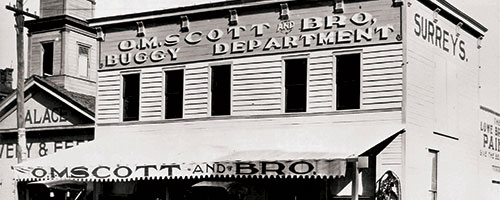 Birth of an Industry 1868
Birth of an Industry 1868After discharge from the Union Army, Orlando McLean Scott embarked on a new business venture—a venture based upon his firm conviction that "farmers need and shall have clean, weed-free fields."
-
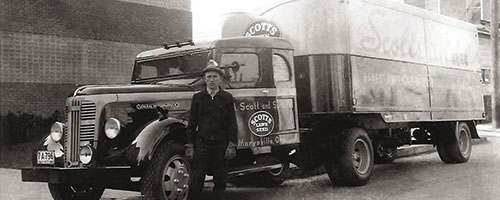 Consumer Outreach 1907
Consumer Outreach 1907O.M. Scott’s elder son, Dwight, saw the role lawns should play in American life. This led to the selling of grass seed by mail.
-
First Retail Outlet 1924
Prior to 1924, consumers could only purchase Scotts seed through the mail. Then a shipment of Scotts products was made to the J.L. Hudson Company, a department store in Detroit. The results were very successful and initiated a new direction for Scotts' business.
-
Turf Builder® 1928
Scotts was first to recognize that grass has special nutritional needs that require a specifically designed fertilizer.
-
The Million Dollar Club & Scotts Spreader 1930
During 1930, Scotts' sales reached an all-time record high of $1,000,000, and the associate population totaled 66. Also, the spreader was created for even, accurate application, essential for better lawn care results.
-
Research Division 1946
Research had always been a part of Scotts, but it was now organized as a full-time division—the first such commercial organization devoted exclusively to turfgrass research.
-
Weed & Feed 1947
The first selective weed control and fertilizer combination was introduced in convenient, dry-applied form.
-
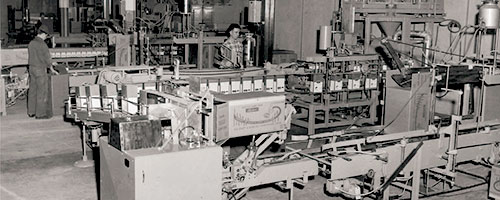 Seed Plant 1953
Seed Plant 1953Scotts' seed processing facility was erected. This was the first and only automated electronic seed processing and packaging plant in the industry.
-
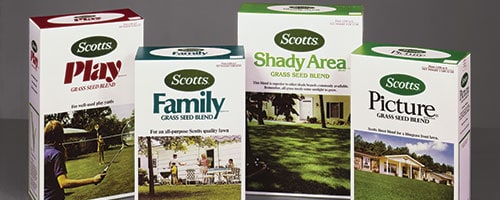 Box Seed Product Line 1956
Box Seed Product Line 1956Picture®, Family®, and Play® lawn seed products were introduced into the retail market.
-
New Trionized® Turf Builder® 1956
A 123,000-square-foot plant was built to house the first lightweight fertilizer designed specifically for the complex nutritional requirements of grass. This completely new fertilizer removed excess weight, smell, dirt, dust and the danger of grass burn to revolutionize lawn feeding. This was the first controlled release of nitrogen using ureaformaldehyde technology. This product started selling in retail stores in 1957.
-
Halts® 1958
Halts was introduced as the first pre-emergent crabgrass control.
-
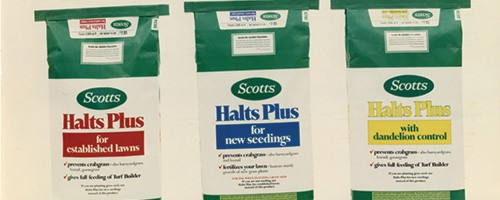 Halts® Plus 1964
Halts® Plus 1964This was the first combination crabgrass preventer and fertilizer.
-
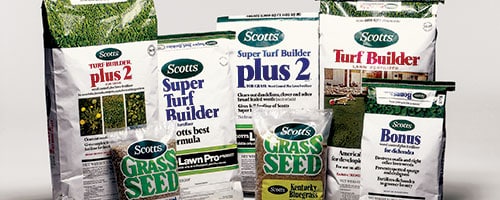 Turf Builder® Plus Products 1964
Turf Builder® Plus Products 1964A complete line of Turf Builder combination products was introduced. They combined a full feeding of Turf Builder fertilizer with control of fungus and disease (Plus 1); rosette and vining weeds (Plus 2); weed and insect control for dichondra lawns (Plus 3); and crabgrass prevention, rosette and vining weeds and insects (Plus 4).
-
Consumer Helpline 1972
A direct customer helpline was introduced to allow lawnowners to phone Scotts for advice and assistance. Scotts' long-standing guarantee of satisfaction was formally named the "No-Quibble" guarantee.
-
Dwight G. Scott Research Center 1974
Completed and opened in 1974, this facility covers 69,820 square feet. Included are research offices, thirteen laboratories, a library and four greenhouses. More than 110 acres of research plots surround the buildings.
-
Products to Canada 1977
Scotts introduced its retail product line into Canada through a distributorship arrangement with Home Hardware.
-
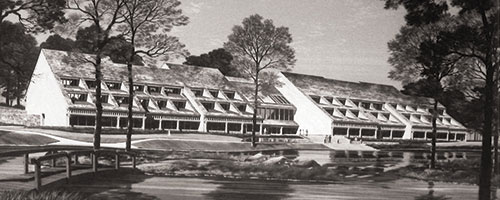 Corporate Headquarters 1982
Corporate Headquarters 1982For the first time in Scotts' over 100 years of existence, all administrative departments were located in one facility––a new Corporate Headquarters building on Scottslawn Road in Marysville, Ohio.
-
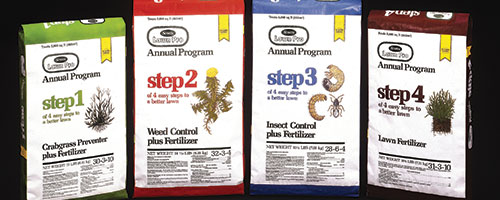 4-Step™ Annual Program 1984
4-Step™ Annual Program 1984Scotts successfully introduced a new Lawn Pro Annual Program in response to the competitiveness of the lawn care service industry, helping consumers better understand what to do and when to do it.
-
Hyponex® 1988
Scotts acquired the lawn and garden business of Hyponex Corporation, the largest producer and marketer of organic growing media products in the U.S.
-
MURP Technology 1992
A new molten urea reaction process (MURP) made it possible to produce a fertilizer in which two nutrients could be used as a carrier for nitrogen, making products less bulky and lighter.
-
Initial Public Offering 1992
Scotts' initial offering of common stock began trading on NASDAQ at $19.00 per share.
-
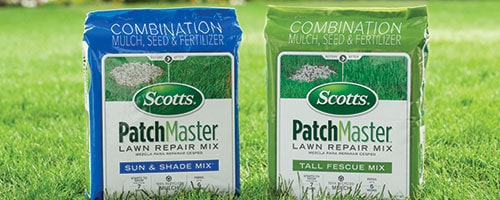 PatchMaster® 1993
PatchMaster® 1993This new combination of Scotts grass seed, Starter® Fertilizer and mulch made seeding bare spots easier than ever for lawnowners.
-
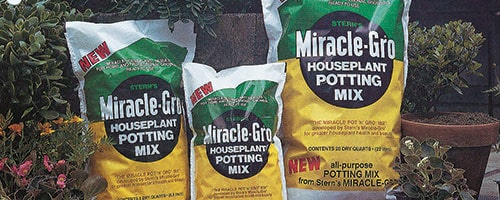 Miracle-Gro® 1995
Miracle-Gro® 1995Horace Hagedorn and his partner Otto Stern founded the Miracle-Gro organization in 1951 dedicated to the proposition that "you don't have to be an expert to create a beautiful garden." Scotts merged with Stern's Miracle-Gro Products, Inc. in 1995, joining America's leading brand name in gardening with the leading name in lawn care.
-
Emerald Green® Lawn Service 1997
Acquiring a majority interest of Emerald Green Lawn Service in 1997 provided Scotts with a base for establishing the new Scotts Lawn Service in 1998.
-
EarthGro® 1998
Acquiring the organics company EarthGro, Inc., strengthened Scotts' service to mass merchant retailers and home centers in the important Northeast region, as well as enhanced Scotts' ability to service independents.
-
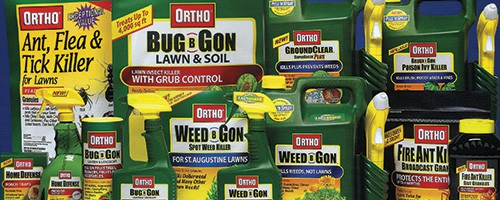 Ortho®/Roundup® 1999
Ortho®/Roundup® 1999Entering into the pesticide industry, Scotts completed agreements for exclusive marketing rights to consumer Roundup herbicide products and for the purchase of the Ortho businesses.
-
Name Change 2005
The company was renamed The Scotts Miracle-Gro Company to reflect the strength of its two leading brands.
-
EZ Seed® Launch 2010
EZ Seed garnered an estimated $87.8M in its national launch year. It introduced patching products to current seed users––52% had never used a grass seed patching product before.
-
Acquisition of Tomcat® 2013
This No. 1 product line has major advantages to competitors on the market and is backed by 40 years of rodent research from our partners at Bell Laboratories.
-
Hawthorne Gardening Company 2014
Hawthorne Gardening Company was formed as a wholly owned subsidiary to focus on hydroponic growing, from greenhouses to indoor and urban gardening. Hawthorne went on to build a robust portfolio by acquiring leading hydroponic brands in nutrients, growing media, ventilation and lighting.
-
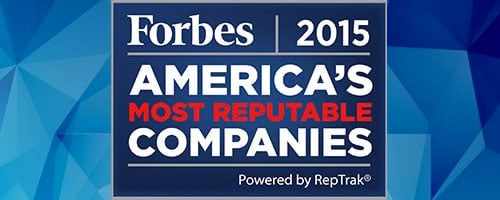 Forbes top 100 most reputable companies 2015 - 2016
Forbes top 100 most reputable companies 2015 - 2016ScottsMiracle-Gro ranked for two consecutive years in the top 100 on Forbes America's Most Reputable Companies.
-
Edible Gardening 2016
The company formed a joint venture with Bonnie Plants®, the largest U.S. grower of vegetables and live goods.
-
150 Years and Counting 2018
ScottsMiracle-Gro marked its 150th anniversary.
-
Sunlight Supply 2018
The company acquired Sunlight Supply, a state-of-the art hydroponics manufacturer and distributor. The acquisition is the largest in the company’s history.
-
Miracle-Gro® Performance Organics® 2019
The company launched Miracle-Gro Performance Organics, an organic product that performs as well as conventional Miracle-Gro. It marked the largest new product launch of 2019.

